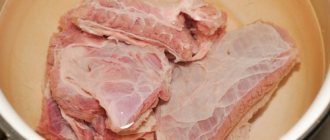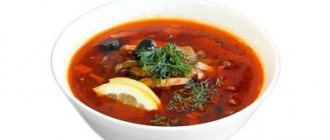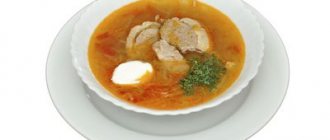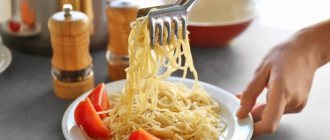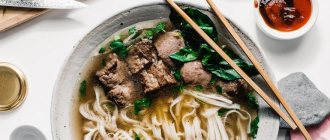What are the benefits of kharcho soup?
What calorie content does kharcho soup have, what beneficial properties does it have? All this is of great interest to those who lead a healthy lifestyle and take care of their health and figure. So we will try to answer these questions in the next article.
So here it is:
Kharcho soup, the national Georgian soup, is made exclusively from beef. Beef is the most popular and sought after product in the human diet. The nutritional value of beef is determined by the fact that it is a carrier of complete animal protein and fat. Some of the nutrients it contains, due to their nutritional value, balance, chemical composition and properties, cannot be replaced by the consumption of other foods. In addition to complete animal protein and fat, beef contains extractives, minerals, water-soluble and coagulating proteins, as well as vitamins and mineral salts.
Among the minerals important for the body, beef includes iron, potassium, magnesium, sodium, zinc, phosphorus, iodine, etc. Vitamins supplied to the body with meat include thiamine, riboflavin, pyridoxine, choline, nicotinic and pantothenic acids, tocopherols, and also a wide complex of vitamin B – B1, B2, B3, B6, B12.
Beef contains nitrogenous and non-nitrogenous extractive substances, which are extracted from it by water during cooking. The extractive substances themselves have almost no nutritional value, but serve as strong stimulants of gastric secretion, helping to increase appetite and better absorption of food.
Just for weight loss
Supporters of the Atkinson diet will be satisfied with the kharcho. This diet relies on reduced consumption of carbohydrates - the main source of fat accumulation by the body.
Most other diets appeal to avoiding fatty foods. According to their authors, the amount of fat in daily consumption should not exceed 20-25% - parameters into which beef kharcho almost fits. And if you cook it from chicken, or even better, from breasts, then the soup falls into the category of dishes that are suitable for losing weight or maintaining it at the same level.
How many calories are in kharcho soup with beef?
Here's how much:
Prepare according to this recipe:
Products (for 6 servings):
- Beef - 500 g - (935 kcal)
- Onions – 100 g. – (41 kcal)
- Rice – 200 g. – (688 kcal)
- Tomato paste – 25 g. – (23 kcal)
- Adjika – 50 g. – (29 kcal)
- Vegetable oil - 3 tbsp. l. — (363 kcal)
- Bay leaf - 1-2 pcs.
- Pepper - 4-5 peas
- Greens, salt - to taste
- Salt - to taste
- Garlic - 3 cloves
- Water – 2 l.
How to cook:
- Pour water into the pan, cut the beef into small pieces, wash it and let it cook until the beef is half cooked, this is about 40 minutes. Don’t forget to skim off the foam before it boils.
- Wash the rice and add it to the pan along with the washed and diced onion. Cook for 20 minutes.
- Wash and chop the greens. After 20 minutes, put half the greens, adjika, salt and pepper into the pan.
- Heat a frying pan with 3 tablespoons of vegetable oil and tomato paste, stir and add to the soup.
- Add peeled chopped garlic, remaining herbs, bay leaf to the pan and let simmer for 5 minutes over low heat with the lid closed.
- Peel and chop the garlic. Add garlic, remaining herbs and bay leaf to the soup. Let everything simmer together over low heat for 5 minutes with the lid closed.
Based on the posted recipe:
Calorie content of kharcho soup with beef, per 100 grams, is:
Calorie content of beef kharcho
It is average - about 300 kilocalories per serving (400 grams). How many calories are needed daily was found out a long time ago. Taking into account age, every day a man consumes 2600-3700 kcal, a woman - 2200-3150. That is, the calorie share of soup in the daily diet is 8-11% for men, the weaker sex - 10-13%.
If you use pork, the energy value of the soup will increase. A serving will include 320-340 kilocalories, the average is 10% of the daily value for men, and 12% for women.
Lamb and chicken are less popular as meat components. Poultry meat is generally considered a forced replacement - in terms of taste, it is poorly suited to the spiciness of the food. But it reduces the number of its calories - 280-290. If you use chicken breasts, the figure decreases further - approximately 260-270 kcal per serving. Fans of spicy first courses who decide to lose weight should stop at the last recipe.
Kharcho soup with meat
Why information about the composition of a product is useful
Some people do not know that there is such a term as the total calorie content of products, and this is unfortunate, because this is the most valuable value, because your well-being depends on it. In this regard, we will now try to consider this modern term in detail.
Kilocalories estimate the energy component of food products. Having data on the calorie content of several products, you will have a chance to accurately calculate the calorie component of the dinner menu that you plan to please, for example, your friends.
Meanwhile, as a rule, having information only about the calorie component of products, namely, one hundred percent knowing the calorie content of products, will not be enough; in addition to the energy value of our menu, we certainly need to take into account what chemical elements they contain, these are: the amount of fat, proteins and saccharides, as well as the presence of liquid and other important substances. In addition, you need to constantly take into account how many calories you burn throughout the day. The amount of energy a person can burn during the day usually depends on daily activity, metabolic rate and your age.
A girl’s body, as a rule, can lose a couple of thousand calories a day. Then, in order to increase the burning of energy obtained from food, you need to regularly perform various sports exercises and lead an active lifestyle - skating, skiing, doing pull-ups, swimming, aerobics, dancing.
Simple saccharides that enter the human body with buns, fruits, honey, cookies are immediately absorbed, without even reaching the esophagus. The remaining undigested carbohydrates will be deposited in the body's cells in the form of fat deposits.
Everyone knows that polypeptides and triglycerides are used for cell regeneration and growth. To provide the body with the necessary biochemicals, you should consume at least 400 grams of carbohydrates, 80 grams of protein and one hundred grams of fat per day. The body receives all these important substances from foods, so it is advisable to know exactly their composition.
It's important to know that different types of nutrients speed up your body's metabolism at different rates and, accordingly, cause different feelings of fullness in a person.
For example, the body prefers to spend carbohydrates, substances with a quickly extracted energy content, primarily on current physical needs. The possibilities for storing carbohydrates in the form of glycogen, or for converting carbohydrates into triglycerides, are greatly limited.
In this regard, carbohydrates, even in very small quantities in food, cause a person to feel full, forcing the person to stop eating.
Polypeptides behave the same way. The body does not create their reserves. Any eaten polypeptides are sent either to replace protein molecules in tissues, or a small part is used for energy needs. People cannot absorb much protein - there is nowhere to put it. Hence, protein foods are also quite filling.
Source: https://specdieta.ru/sup-harcho-s-mjasom.html
Kharcho soup: chicken recipe
As previously noted, classic beef kharcho is a rather fatty and spicy dish, the preparation of which requires a lot of spices, which not every housewife has on hand. If you use a chicken recipe for making kharcho , there will be no problems with these ingredients, since a ready-made seasoning is added to the soup to replace them.
In order to prepare chicken kharcho soup, the calorie content of which, due to the lack of tkemali and nuts in it, is significantly lower than that of a dish with beef, you will need the following ingredients:
- Chicken meat* – 0.25 kg
- Carrots - 1 pc.
- Water - 1.5 l
- Rice - 100 g
- Green onion – 50 g
- Sunflower oil - 3 tbsp.
- Garlic - 3 teeth.
- Tomato paste (sauce) - 2 tbsp.
- Seasoning for kharcho** - 2 tbsp.
- Salt, pepper - to taste.
* The calorie content of ready-made kharcho soup depends on the meat chosen for its preparation. The most high-calorie chicken kharcho soup recipe is made from wings, and the most dietary one is made from fillet.
** You can also use khmeli-suneli seasoning to prepare kharcho recipe with chicken.
Kharcho: step-by-step chicken recipe
1) In order to prepare kharcho according to the recipe, first of all, cook the broth from chicken, boiling rice with meat.
- Before this, wash the chicken prepared for making kharcho soup according to the recipe and cut it into medium-sized pieces.
Cut medium sized chicken into pieces
- Place the meat in a saucepan with water and place on high heat.
- When the broth boils, skim off any foam that has formed and add rice to the pan. Before putting rice in kharcho (whether you use a chicken recipe or a traditional one, it doesn’t matter), it should be thoroughly washed.
2) Cut the carrots into pieces.
Cut carrots into pieces
3) Chop the onion and garlic.
4) Lightly fry the carrots and add them to the soup.
5) After this, we fry the vegetables necessary for preparing the kharcho soup according to the recipe - the chicken and rice should already be ready by this time:
- Lightly fry garlic and onion in a frying pan in vegetable oil, add tomato paste to them and fry for a few more minutes.
Fry onions and garlic with tomato paste
- After this, add a couple of tablespoons of chicken broth to the pan and simmer everything together for a few more minutes.
6) Send the frying for kharcho according to the recipe for chicken and rice in the broth.
7) Then cook the kharcho soup for another 10 minutes - the chicken recipe allows you to prepare the dish quite quickly.
 After this, add salt, pepper and seasoning to the kharcho, after a few minutes turn off the heat and let the soup brew.
After this, add salt, pepper and seasoning to the kharcho, after a few minutes turn off the heat and let the soup brew.
Kharcho soup recipe. Calorie, chemical composition and nutritional value.
Nutritional value and chemical composition of “Kharcho soup”.
The table shows the nutritional content (calories, proteins, fats, carbohydrates, vitamins and minerals) per 100 grams of edible portion.
| Nutrient | Quantity | Norm** | % of the norm in 100 g | % of the norm in 100 kcal | 100% normal |
| Calorie content | 75 kcal | 1684 kcal | 4.5% | 6% | 2245 g |
| Squirrels | 2.9 g | 76 g | 3.8% | 5.1% | 2621 g |
| Fats | 4 g | 56 g | 7.1% | 9.5% | 1400 g |
| Carbohydrates | 6.7 g | 219 g | 3.1% | 4.1% | 3269 g |
| Organic acids | 0.3 g | ~ | |||
| Alimentary fiber | 0.6 g | 20 g | 3% | 4% | 3333 g |
| Water | 85.6 g | 2273 g | 3.8% | 5.1% | 2655 g |
| Ash | 0.352 g | ~ | |||
| Vitamins | |||||
| Vitamin A, RE | 32.1 mcg | 900 mcg | 3.6% | 4.8% | 2804 g |
| Retinol | 0.019 mg | ~ | |||
| alpha carotene | 1.35 mcg | ~ | |||
| beta carotene | 0.149 mg | 5 mg | 3% | 4% | 3356 g |
| beta Cryptoxanthin | 7.578 mcg | ~ | |||
| Lutein + Zeaxanthin | 32.449 mcg | ~ | |||
| Vitamin B1, thiamine | 0.026 mg | 1.5 mg | 1.7% | 2.3% | 5769 g |
| Vitamin B2, riboflavin | 0.023 mg | 1.8 mg | 1.3% | 1.7% | 7826 g |
| Vitamin B4, choline | 11.34 mg | 500 mg | 2.3% | 3.1% | 4409 g |
| Vitamin B5, pantothenic | 0.177 mg | 5 mg | 3.5% | 4.7% | 2825 g |
| Vitamin B6, pyridoxine | 0.08 mg | 2 mg | 4% | 5.3% | 2500 g |
| Vitamin B9, folates | 5.488 mcg | 400 mcg | 1.4% | 1.9% | 7289 g |
| Vitamin B12, cobalamin | 0.35 mcg | 3 mcg | 11.7% | 15.6% | 857 g |
| Vitamin C, ascorbic acid | 2.21 mg | 90 mg | 2.5% | 3.3% | 4072 g |
| Vitamin E, alpha tocopherol, TE | 0.516 mg | 15 mg | 3.4% | 4.5% | 2907 g |
| Vitamin H, biotin | 0.494 mcg | 50 mcg | 1% | 1.3% | 10121 g |
| Vitamin K, phylloquinone | 11.8 mcg | 120 mcg | 9.8% | 13.1% | 1017 g |
| Vitamin RR, NE | 0.8491 mg | 20 mg | 4.2% | 5.6% | 2355 g |
| Niacin | 0.055 mg | ~ | |||
| Macronutrients | |||||
| Potassium, K | 90.93 mg | 2500 mg | 3.6% | 4.8% | 2749 g |
| Calcium, Ca | 11.91 mg | 1000 mg | 1.2% | 1.6% | 8396 g |
| Silicon, Si | 1.921 mg | 30 mg | 6.4% | 8.5% | 1562 g |
| Magnesium, Mg | 9.73 mg | 400 mg | 2.4% | 3.2% | 4111 g |
| Sodium, Na | 66.36 mg | 1300 mg | 5.1% | 6.8% | 1959 |
| Sera, S | 32.05 mg | 1000 mg | 3.2% | 4.3% | 3120 g |
| Phosphorus, P | 39.6 mg | 800 mg | 5% | 6.7% | 2020 |
| Chlorine, Cl | 9.41 mg | 2300 mg | 0.4% | 0.5% | 24442 g |
| Microelements | |||||
| Aluminium, Al | 25.7 mcg | ~ | |||
| Bor, B | 17 mcg | ~ | |||
| Vanadium, V | 0.91 mcg | ~ | |||
| Iron, Fe | 0.437 mg | 18 mg | 2.4% | 3.2% | 4119 g |
| Yod, I | 0.4 mcg | 150 mcg | 0.3% | 0.4% | 37500 g |
| Cobalt, Co | 1.243 mcg | 10 mcg | 12.4% | 16.5% | 805 g |
| Lithium, Li | 0.075 mcg | ~ | |||
| Manganese, Mn | 0.1639 mg | 2 mg | 8.2% | 10.9% | 1220 g |
| Copper, Cu | 68.67 mcg | 1000 mcg | 6.9% | 9.2% | 1456 g |
| Molybdenum, Mo | 1.859 mcg | 70 mcg | 2.7% | 3.6% | 3765 g |
| Nickel, Ni | 5.941 mcg | ~ | |||
| Rubidium, Rb | 32.4 mcg | ~ | |||
| Selenium, Se | 1.399 mcg | 55 mcg | 2.5% | 3.3% | 3931 g |
| Strontium, Sr | 0.09 mcg | ~ | |||
| Titanium, Ti | 0.24 mcg | ~ | |||
| Fluorine, F | 84.77 mcg | 4000 mcg | 2.1% | 2.8% | 4719 g |
| Chromium, Cr | 0.98 mcg | 50 mcg | 2% | 2.7% | 5102 g |
| Zinc, Zn | 0.552 mg | 12 mg | 4.6% | 6.1% | 2174 g |
| Zirconium, Zr | 0.16 mcg | ~ | |||
| Digestible carbohydrates | |||||
| Starch and dextrins | 0.229 g | ~ | |||
| Mono- and disaccharides (sugars) | 0.7 g | max 100 g | |||
| Glucose (dextrose) | 0.091 g | ~ | |||
| Sucrose | 0.453 g | ~ | |||
| Fructose | 0.084 g | ~ | |||
| Essential amino acids | 0.02 g | ~ | |||
| Arginine* | 0.109 g | ~ | |||
| Valin | 0.054 g | ~ | |||
| Histidine* | 0.022 g | ~ | |||
| Isoleucine | 0.042 g | ~ | |||
| Leucine | 0.072 g | ~ | |||
| Lysine | 0.032 g | ~ | |||
| Methionine | 0.019 g | ~ | |||
| Methionine + Cysteine | 0.013 g | ~ | |||
| Threonine | 0.034 g | ~ | |||
| Tryptophan | 0.011 g | ~ | |||
| Phenylalanine | 0.047 g | ~ | |||
| Phenylalanine+Tyrosine | 0.041 g | ~ | |||
| Nonessential amino acids | 0.046 g | ~ | |||
| Alanin | 0.037 g | ~ | |||
| Aspartic acid | 0.078 g | ~ | |||
| Glycine | 0.049 g | ~ | |||
| Glutamic acid | 0.183 g | ~ | |||
| Proline | 0.042 g | ~ | |||
| Serin | 0.044 g | ~ | |||
| Tyrosine | 0.032 g | ~ | |||
| Cysteine | 0.013 g | ~ | |||
| Sterols (sterols) | |||||
| Phytosterols | 0.188 mg | ~ | |||
| Stigmasterol | 0.113 mg | ~ | |||
| beta sitosterol | 1.147 mg | ~ | |||
| Saturated fatty acids | |||||
| Saturated fatty acids | 0.2 g | max 18.7 g | |||
| 14:0 Miristinovaya | 0.014 g | ~ | |||
| 16:0 Palmitinaya | 0.163 g | ~ | |||
| 18:0 Stearic | 0.058 g | ~ | |||
| 20:0 Arakhinovaya | 0.002 g | ~ | |||
| 22:0 Begenovaya | 0.004 g | ~ | |||
| Monounsaturated fatty acids | 0.546 g | min 16.8 g | 3.3% | 4.4% | |
| 16:1 Palmitoleic | 0.006 g | ~ | |||
| 18:1 Oleic (omega-9) | 0.446 g | ~ | |||
| 20:1 Gadoleic (omega-9) | 0.029 g | ~ | |||
| 22:1 Erucic (omega-9) | 0.064 g | ~ | |||
| Polyunsaturated fatty acids | 1.445 g | from 11.2 to 20.6 g | 12.9% | 17.2% | |
| 18:2 Linolevaya | 1.224 g | ~ | |||
| 18:3 Linolenic | 0.192 g | ~ | |||
| Omega-3 fatty acids | 0.2 g | from 0.9 to 3.7 g | 22.2% | 29.6% | |
| Omega-6 fatty acids | 1.2 g | from 4.7 to 16.8 g | 25.5% | 34% |
The energy value of Kharcho soup is 75 kcal.
Primary Source: Created in the application by the user. Read more.
** This table shows the average levels of vitamins and minerals for an adult. If you want to know the norms taking into account your gender, age and other factors, then use the “My Healthy Diet” application.
